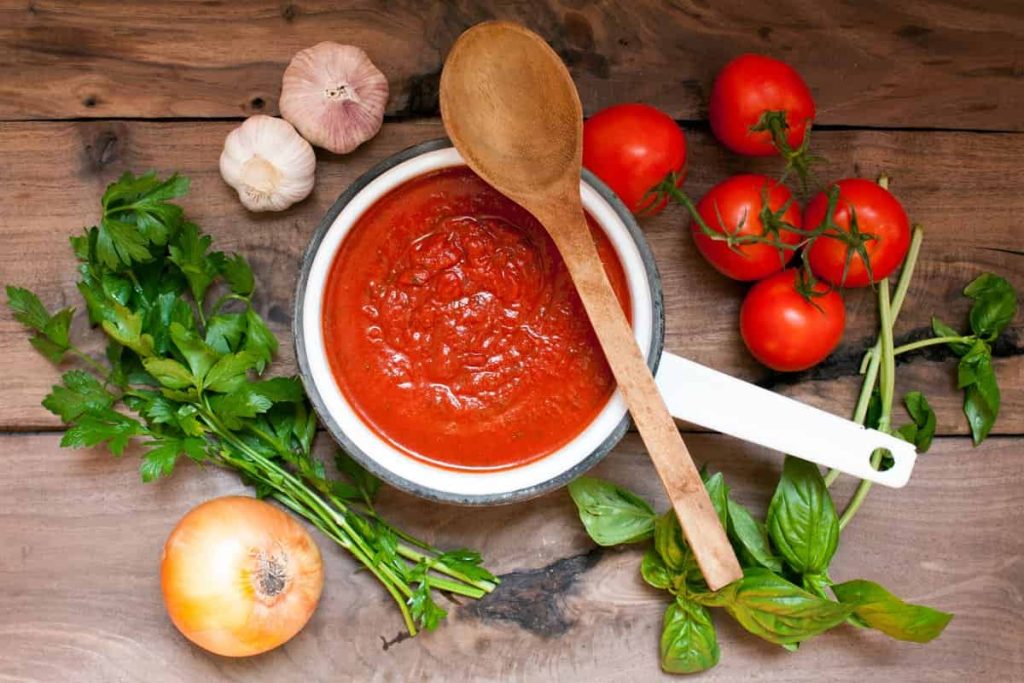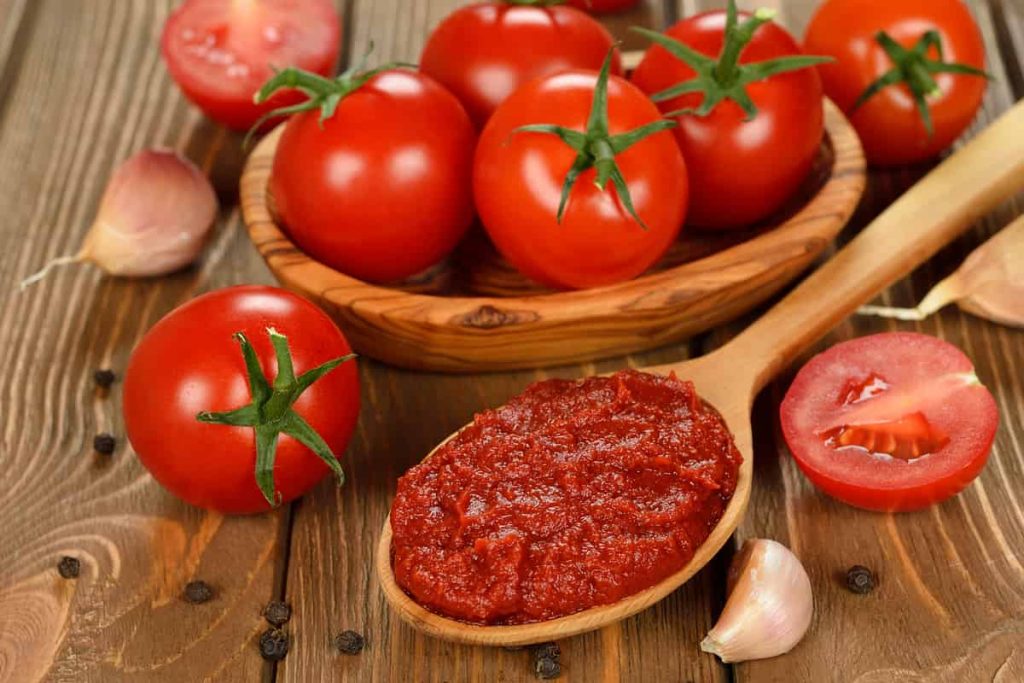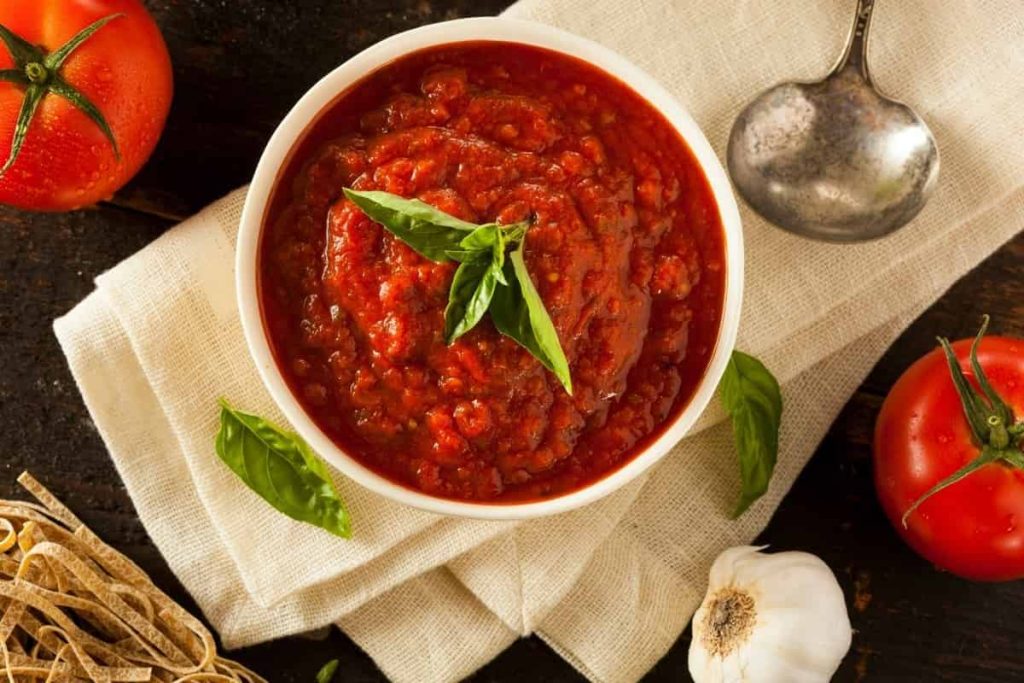In the vs of tomato paste, you can compare some other products such as tomato sauce when it comes to the production, quality, and taste. The process of production will be more complicated if a frying form for tomato paste is required.
When you go to your neighborhood grocery store, it’s easy to become overwhelmed by the countless tomato-based goods that are located near the section that sells pasta. Marinara sauce, tomato sauce, and tomato paste are frequently all presented alongside one another.
Despite the fact that they could appear to be interchangeable, there are a few crucial distinctions that set each one apart from the others.
In what follows, we will explain what you need to know about each one so that you can make sure you are using the one that is most suitable for the food you are preparing.
Tomato Paste Versus Tomato Sauce
This tomato product is a highly concentrated paste that is available in either a tube or a can (we recommend selecting a tube if you have the option, as it will protect the paste from going bad once it is exposed to oxygen). You may find this tomato product at your local grocery store.
Cooking down tomatoes, removing their seeds and liquids, and continuing the process until all that is left is a very concentrated, extremely thick, and extremely tomato-flavored product is the process by which tomato paste is produced. Tomato sauce, on the other hand, is typically created with a large number of aromatic ingredients and has a watery consistency.
Because tomato paste has such a concentrated taste, you often only need to use a couple of teaspoons in each recipe. For example, whether preparing a traditional beef stew or making your own handmade marinara sauce, you would only need to use a couple of tablespoons.
Tomato paste is typically marketed in increments of four to six ounces, irrespective of whether it is packaged in a tube or a can.
You could also create it on your own; all you need is five pounds of chopped tomatoes, some extra virgin olive oil, and some salt. Cook all three components together in a saucepan until the mixture reaches the desired consistency, then transfer to a container with a tight-fitting lid and place in the refrigerator for up to three months.

Marinara Sauce Versus Tomato Sauce
Marinara sauce and tomato sauce are not the same things, despite the fact that they are used for some of the same purposes (such as a flavorful topping for pizza or a sauce for bucatini or spaghetti), respectively. Tomato sauce is a more labor-intensive and time-consuming product than its counterpart, marinara sauce.
Crushed tomatoes are used to make marinara sauce, which can be served chunky or smooth. On the other hand, tomato sauce is usually made by puréeing whole tomatoes.
However, according to Italian-American culinary writer Domenica Marchetti, regionality plays a significant influence when determining how these two sauces are created.
This is similar to the case with many other types of foreign meals. “If you get ten Italian cooks in a room together, each one of them will tell you a different version of what marinara sauce is,” she explains. “Everyone has their own interpretation.”
Marchetti claims that the definition of marinara is, historically speaking, “being reminiscent of the manner of a sailor In Naples, the seafood component of spaghetti marinara comes from the addition of anchovies or tuna to the tomato sauce that makes up the dish.”
Many individuals, particularly in the United States, refer to a marinara sauce that contains anchovies, capers, and olives as puttanesca sauce.
This is because the marinara sauce has the same ingredients as puttanesca sauce. According to Marchetti, “these foods that share names might be very different depending on where you are in Italy and who is doing the cooking.”
The majority of chefs will agree that for a basic Pomodoro or tomato sauce, it should be made using fresh or canned tomatoes, extra-virgin olive oil, chopped onions, basil, and parsley. These ingredients can be found in most grocery stores.
According to Marchetti, the definition of tomato sauce in some Italian-American cookbooks may be as simple as a sauce that is heated rapidly and seasoned with garlic, basil, and either fresh or dried oregano.

The majority of jars of sauce sold in grocery stores across the United States are branded as “tomato sauce” or “marinara sauce,” despite the fact that they do not include ingredients such as anchovies, capers, or olives. Other adjectives can be used to describe the texture of a particular sauce, such as chunky or smooth, or they can name specific herbs, such as basil.
Always be sure to check the label on the back of the jar to ensure that the ingredients contained within the sauce will satisfy your taste preferences as well as those of your family.
Tomato paste and tomato sauce are not the same thing at all for a number of reasons. In point of fact, the only similarity between the two is that they are both prepared with tomatoes.
What is the main dissimilarity between tomato sauce and tomato paste? Tomato paste, in contrast to tomato sauce, possesses a taste that is more concentrated, and a texture that is somewhat thicker, and is utilized in cooking to improve the flavor of other ingredients.
In contrast to tomato sauce, tomato paste is not used as the “tomato” component of a dish; rather, it functions more as a flavoring agent that contributes depth to the dish.
The Key Distinctions Between Tomato Paste and Tomato Sauce
Have you ever seen tomato paste sold in the aisles of a grocery store in little jars or tubes? You have undoubtedly considered that a purchase of such a little quantity of a product is not worthwhile.
Surprisingly, a small amount of tomato paste, such as a teaspoon, can go a very long way. Tomatoes that have been thoroughly boiled in order to remove all of their moisture have been used to create this nutrient-dense concentrate.
On the other hand, tomato sauce does not have the same level of concentration. It consists of tomatoes that have been simmered for a short time in a substantial amount of liquid and can be used to generate a flavorful sauce for dishes such as pasta, pizza, meatballs, and so on.

Consistency
The consistency is one of the most distinguishing features that set tomato paste apart from tomato sauce.
The tomato sauce has a lot of moisture in it. When you pour it onto a plate, it will swiftly spread out to cover the entire surface. On the other hand, tomato paste has a highly consistent consistency.
The only way to get it to start coming apart is to either combine it with some form of liquid or place it in a heating pan with some oil.
The two products have different consistencies because of the different amounts of tomato solids that are contained in each of them.
Tomato paste has a much denser and heavier consistency than tomato sauce, which has a much runny and fluid quality. It has as much as 24 percent tomato solids in it.
On the other hand, tomato paste has more than 24 percent solid tomato content. The method by which the tomato paste is prepared is directly related to the consistency of the final product. Tomatoes are cooked so long that the water content falls to a minimum, leaving a thick paste behind.
Both of these items are created with tomatoes that have been peeled. Seeds are also removed.
Taste
A flavor that is comparable to that of dried tomatoes can be found in tomato paste. It has a notable sourness, unlike tomato sauce, which does not have this characteristic. The latter has a taste mimicking fresh tomatoes.
Because it is so concentrated, tomato paste has a flavor that is reminiscent of meat. In cooking, it is frequently used to impart a savory umami taste to the meal as well as to amplify the flavor of other components.











Your comment submitted.